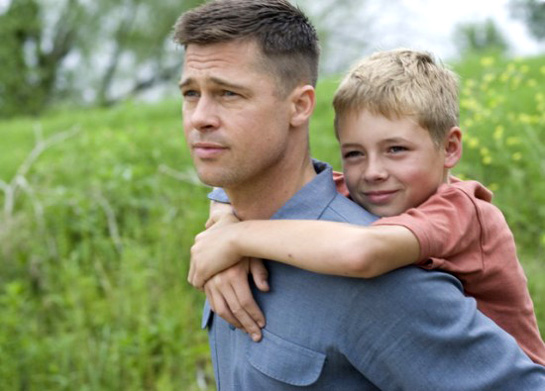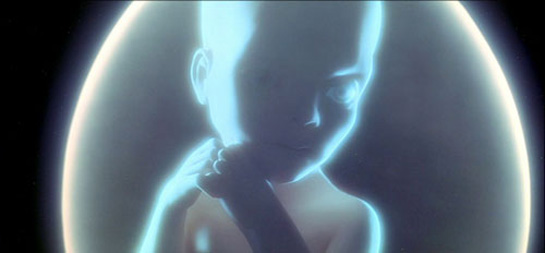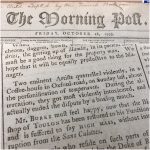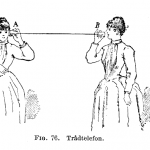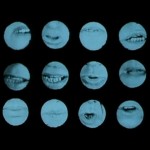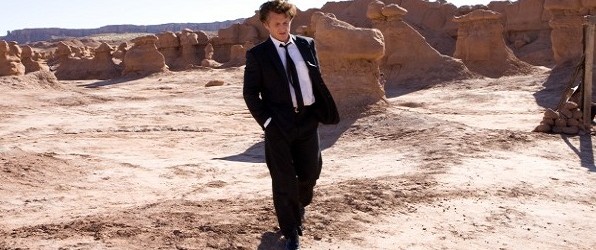
Pruning ‘The Tree of Life’
Commentary, Film, ReviewsTerrence Mallick movies are about questions. The Big questions, ones without answers, and his characters often spend more time asking those Big questions via whispered voice-over than they do engaging with one another. It is this free-form existential searching that is polarizing for audiences and critics alike, capable of brilliance though constantly teetering towards unforgiveable pretentiousness. His films have taken the most American moments (early 20th century Texan farm life, WWII, 17th century colonization) and used them to explore the human condition and our metaphysical relationship with the realms of both the spiritual and the natural. The Thin Red Line, released in 1998, was a beautiful, lyrical foil to the Oscar-ready Saving Private Ryan, one that breathed so much life and humanity into the soldiers lost in the field of battle. The New World took audiences on a brutal expedition through love and pain, learning the grammar of the spirit just as a re-imagined Pocahontas learned our language.
The Tree of Life, Mallick’s latest and winner of the 2011 Palme D’Or at Cannes, is a lyrical, over-long prayer about beauty, life and loss. Like Mallick’s past work, it’s full of all those Big questions, but this time around the visceral meditation becomes lost in device, oversaturation and pretension. It’s a frustrating experience because in the midst of it all, there is a very brilliant movie that exists, one that understands family and humanity in a devastatingly honest way. The power of the body of the piece makes it all the more disappointing as it proves to be a monolith of big-budget art-house, suffering endlessly from its own self-importance.
Taking on no smaller a task than pondering the origins of all life in the universe, The Tree of Life weaves dream-like throughout time (dating back billions of years) and a typically loose – or barely existent – narrative plot. Despite the grand task, the film wisely centers on a small family story, set in 1950’s Waco, Texas. A working father, played with great earnestness by Brad Pitt, wrestles with both overwhelming love for his three sons and his era-specific preoccupation with discipline, respect, and material gain. Mr. O’Brien (whose first name we never learn) teaches his boys how to punch, demands they call him “Sir” and explodes at the hint of disobedience, yet at the same time finds solace in their innocent and unquestioning affection. His turmoil between love and order is a precursor for his entire generation’s loss of innocence, led by its offspring in the decades to follow. His wife, Mrs. O’Brien (Jessica Chastain) is far less developed as a character; she is ethereal and free despite living in very pre-hippie 1950’s Texas. She is presented almost as a deity yet rarely opens her mouth, and in doing so may perhaps speak volumes about Mallick’s relationship with the memory of his own parents. It is a disservice to the story however, to not allow her to be as human as the men of her life, which is itself fodder for another essay altogether.
This story at the core the film is the reflective look back of middle son Jack, played as an adult by Sean Penn. Now an architect, Jack also says very little, instead moping through his day-to-day with his own voice-over constantly whispering existential questions to God. Jack as a boy has a conflicted relationship with father, growing to resent his affection but particularly his discipline, to the point that he comes alive when his father leaves on a business trip or wishes him dead at the dinner table. His hurt and animosity is one that we’ve all felt at one point or another, growing up under a domineering shadow, and it is an excitingly honest growing pain to witness. The loose narrative allows this father-son relationship to undergo intensive study, and it is at times heartbreaking. As an adult however, we hear only one conversation between the two, as Jack speaks to his father on the phone while riding an elevator. Grown-up Jack is even less developed than his mother, and as such proves to be a rather redundant plot device, serving only as a conduit for flashbacks and psychobabble.
Framing this story even further is a very long, visually stunning study of the origins of life (including a couple dinosaur scenes!) and the most ludicrously drawn-out, metaphor-laden dénouement in the history of big-budget mainstream film. Of course, there are obvious 2001: A Space Odyssey comparisons, and the analogy has been drawn by countless reviewers. Like 2001, the technically brilliant film – which employed several old-school experimental techniques in creating the film’s visual effects – explores the metaphysical through both the hugeness of the history of the universe, as well as the intimacy of the human experience. Both are audacious beyond their means, and sure to alienate most viewers with attention spans weaned on prime-time television.

But while 2001 is about transcendence, Tree of Life has at its core a central theme of the limiting capacity of humanity over the free, spontaneous beauty of the universe. Over the many minutes of the origin-of-life sequence, we are treated to the raw, explosive evolution of the natural world, in which impulse and accident produce joy and awe and spectacle. In juxtaposition we witness the human experience (here represented by the O’Briens), and see the most complex and amazing species on earth constantly choked by pettiness, rules, and the material desires of a world that has lost sight of simple bliss. It is in this observation that the film is strongest, and most capable of working as a brilliant 90-minute cut. If the film would have started with the Big Bang, taken half as long to get to Waco as it did, and left out the last 20 minutes (and Sean Penn’s completely arbitrary character altogether), this would have been a gushing review of a small film that evoked the hugeness of the universe through very simple truths.
Where the film goes very wrong is in its absolute hammering of the audience with allegory, symbolism and, well, Questions. The film ends with such ambitious yet overly-literal psalms that it borders on self-parody, amplified by how seriously The Tree of Life takes itself. The camera constantly tilts up and stares into the twinkling sun, always reaching out to the God Mallick believes is just on the other side of the clouds. The whispers become so repetitive that they border on grating. At one point, Sean Penn’s Jack is standing in a desert, and has to walk through an empty door frame, chasing after a youthful vision of his mother. It actually evoked a few laughs from the theatre, and was so over-the-top that neither a giant talking snake nor Jim Morrsion’s ghost would have been surprising in a cameo appearance.
The Tree of Life commands viewing on mass scale and for personal judgments to be made. Its audacity puts it in a league of it own, given the star power behind the vehicle. Relationships with God and family will greatly affect how each viewer personally invests and takes away from such a film. However, even a shred of contemporary cynicism can threaten to ruin the entire experience. Pretty as it may be, earnest, allegorical philosophizing has a tough time holding straight faces in the Age of Irony.





